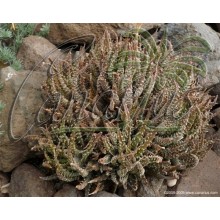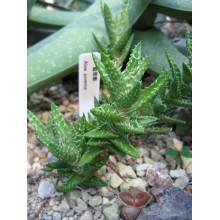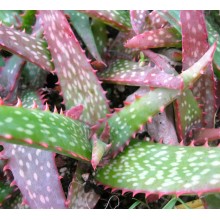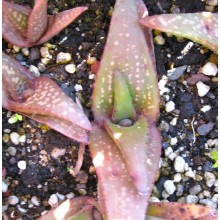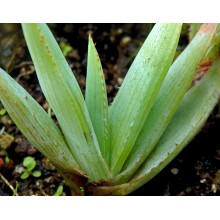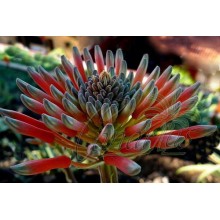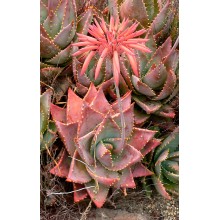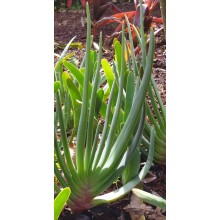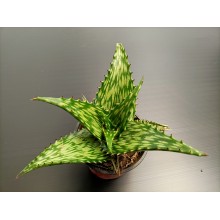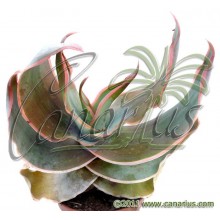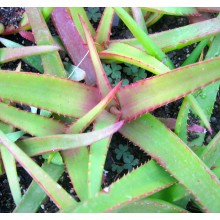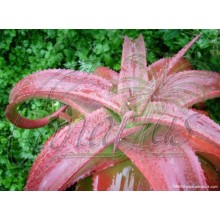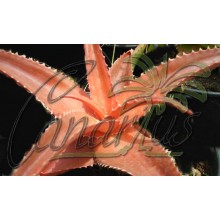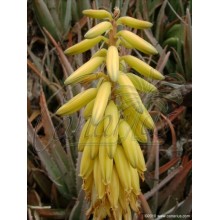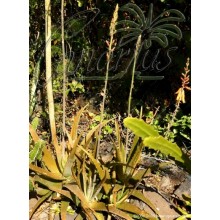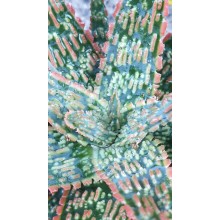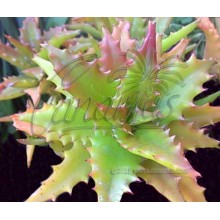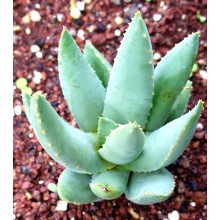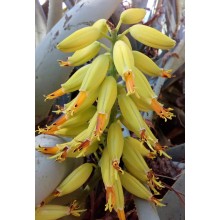Succulentes Il y a 628 produits.

Les plantes les plus intéressantes habitent dans les déserts du monde et les zones sèches. Canarius propose une sélection croissante de plantes succulentes de qualité maximale, car elles sont cultivées à l'extérieur en plein soleil des Canaries.
Les succulentes ou «plantes grasses» sont des espèces de rétention d'eau, adaptées aux conditions sèches. Ils stockent succum (jus, eau) dans leurs feuilles, les tiges ou racines, et ils présentent souvent une apparence robuste et charnue.
Sous-catégories
-
Agave
Agave est un genre de plantes succulentes de l'Amérique. Certaines espèces poussent dans des zones froides et peuvent supporter un gel dur, tandis que d'autres vivent dans des climats tropicaux. Certains sont minuscules nains et certains sont des géants, jusqu'à 2 ou 3 m de large.
Les agaves résistant au froid peuvent créer un effet exotique dans votre jardin. Les espèces d'agaves font une amende compagnon de palmiers ou cactus. Les agaves panachées sont incroyablement recherchés par les collectionneurs. Notre boutique en ligne propose une sélection en constante évolution des espèces. Nous expédions plants à racines nues, sauf indication contraire.
-
Aloe, Gasteria & Haworthia
Aloe, Gasteria et Haworthia sont trois genres connexes, qui comprennent des centaines de plantes succulentes. Ils sont facilement cultivées dans des pots. Quelques-uns s'adaptent à faibles niveaux de lumière dans intérieures et peuvent être cultivées comme plantes d'appartement.
- Aloe est un genre d'environ 400 espèces, originaires d'Afrique, d'Arabie et Madagascar. Petits ou nains aloès sont de plus particulièrement populaire dans les climats froids, car ils peuvent être prises à l'intérieur pendant les mois les plus difficiles.
- Gasteria comprend quelque 80 espèces endémiques à l'Afrique du Sud, connus pour leurs feuilles spectaculaires qui sont brillants, tachetées et texturés. Ils fleurissent au printemps-été avec de longs épis de petites fleurs oranges. Certaines espèces sont tellement variables que nous offrons clones particuliers à partir d'emplacements spécifiques.
- Haworthia est un genre endémique à l'Afrique du Sud avec environ 70 espèces et un certain nombre de sous-espèces locales, variétés et formes. Les feuilles sont souvent bagués, tachetés, parsemées, ou semi-translucide et montrent de grandes variations.
-
Crassulaceae
Cette nouvelle et croissante section des espèces de la famille des Crassulaceae. Il ya environ 1400 espèces dans 33 genres et leur ditribution est dans le monde entier, mais se produisent surtout dans le hémisphère Nord et en Afrique australe, en particulier dans les milieux secs. Ici vous pouvez acheter des plantes saines et durcie par le soleil, cultivées dans les îles Canaries et expédiés à votre domicile.
-
Mesembs
Ce groupe de plantes du désert est surnommé les Mesembs parce qu'ils appartiennent à une famille botanique anciennement appelée les Mesembryanthemaceae. Il y a près de 2. 000 espèces, que l'on peut principalement trouver en Afrique australe, avec des adaptations extrêmes aux habitats secs. Certaines sont appelées "pierres vivantes", car elles ressemblent à des cailloux. Beaucoup sont faciles à cultiver et leur besoin principal est de beaucoup de soleil. Certaines sont difficiles, car elles poussent dans les zones vraiment extrêmes.
Notre boutique en ligne offre des plantes saines cultivées au soleil, avec des feuilles compactes et colorées. Certaines plantes sont vendues sous forme de boutures, et d'autres comme plantes enracinées, d'au moins deux ans.
-
Sansevieria
Récemment réassignée à la famille des Asparagaceae, le genre Sansevieria compte environ 70 espèces, presque toutes originaires de l'Afrique, l'Arabie et Madagascar. Il s'agit d'herbes vivaces adaptées aux habitats secs avec des feuilles raides succulentes, leur longueur est de quelques centimètres à deux mètres. Sansevieria trifasciata et ses nombreux cultivars sont parmi les plantes d'intérieur les plus populaires, populairement appelée "Langues de belle-mère". Une plante qui a bien grandi produit habituellement un pic bien blanc, plein de fleurs parfumées qui donnent des baies orange. Même les espèces les plus rares sont résistantes à la négligence, à condition de les garder du gel en hiver et du soleil brûlant en été.
-
Hoya
Les Hoyas sont des vignes, avec des fleurs exotiques voyantes, que l'on trouve dans les forêts tropicales en Asie et en Océanie. La plupart des espèces grandissent en pleine ombre ou dans le soleil du matin, mais elles vont aussi se développer à l'intérieur comme plantes d'appartement. Elles sont bien adaptées pour les paniers, les treillis ou les échelles. Elles tolèrent quelques semaines de sécheresse, mais sont sensibles au gel et au froid. Beaucoup de hoyas sont faciles à cultiver et à faire fleurir, alors que certains sont difficiles et rares.
-
Asclépias
Les Asclépias sont une sous-famille des Apocynacées disposant de près de 2900 espèces. Il s’agit d’herbes, de buissonnants ou rarement d’arbustes, avec des parties laineuses, avec ou sans liège et des racines fibreuses… Les Asclépias produisent des fleurs assez sophistiquées grâce à leur mécanisme complexe pour développer leur pollinisation. Beaucoup de ces espèces produisent un parfum inhabituel, souvent désigné comme ressemblant à l’odeur de la « charogne », attirant les mouches pour la pollinisation. -
Caduciformes
Ces plantes originaires de régions arides produisent une tige anormalement épaisse : le caudex. Elles sont également appelées Paquicaule et disposent d’un tronc disproportionné; avec souvent peu de branches. Le caudex peut se cacher sous la terre, mais dans la plupart des cas, il est visible, offrant des arbres spectaculaires. Les caudiciformes les plus grands du monde sont les baobabs. -
Autres plantes succulentes
Ici vous trouverez toutes les espèces de plantes du désert qui ne sont pas incluses dans leur propre catégorie. Nous allons placer ici toutes les plantes issues de familles inhabituelles, autres qu’Agaves, les Aloes, Crassulaceae, Sansevieria, Mesembs, cactus épiphyte, etc.
-
Aloe juvenna
Aloe juvenna
Cont. 8 cm. It is native to South Africa and its grows vertically and grouped.Its leaves from green spiral rosettes whith specks and small spines.
10,20 € -
Aloe labworana
Aloe labworana
Stemless aloe with yellow flowers, native to rocky outcrops in the mountains of northern Uganda and southern South Sudan between 1300 and 1500 m.
23,20 € -
Aloe lavranosii
Aloe lavranosii
Aloe lavranosii is a native of Yemen on the Arabian Peninsula. It is one of the few species of Aloe with "hairy" flowers. Plants grow usually solitary with blueish leaves.
14,20 € -
Aloe lineata
Aloe lineata
South African species with blue-green leaves marked with longitudinal red lines (hence "lineata"). It branch from the base and produces erect stems, so it eventually becomes a dome-shaped shrub, 1-2 m tall.
13,40 € -
Aloe maculata
Aloe maculata
10 cm cutting. Slowly clumping rosette,with elegant red inflorescences held on tall stalks. The dark green leaves have the typical white H spots.It is a widespread South African aloe tolerant of different conditions.
10,80 € -
Aloe perfoliata
Aloe perfoliata
Cont. 8 cm. It is native to South Africa and its characterized by prostrate, long and branching stems that isn't stend of growing upright but they tend to sprawl along the ground and over rocks.
11,70 € -
Aloe plicatilis (Kumara plicatilis)
Aloe plicatilis (Kumara plicatilis)
Thick 15-20 cm 1-y old rooted plant - It is a spectacular species, relative of the genus Aloe with leaves arranged as fans. Kumara plicatilis grows as a shrub or small tree and thrives outdoors in the coastal Mediterranean. It blooms in winter and its flowers are much larger than most aloes !
45,00 € -
Aloe plicatilis (Kumara plicatilis)-Large
Aloe plicatilis (Kumara plicatilis)-Large
Thick 26-40 cm 2-y old rooted plant - It is a spectacular species, relative of the genus Aloe with leaves arranged as fans. Kumara plicatilis grows as a shrub or small tree and thrives outdoors in the coastal Mediterranean. It blooms in winter and its flowers are much larger than most aloes !
60,60 € -
Aloe somaliensis
Aloe somaliensis
Elegant spotted aloe from Somalia. The glossy rosettes are often solitary, low growing. Colours change through the seasons, from green to grey, copper, burgundy or brown.
18,20 € -
Aloe striata
Aloe striata
Cont.= 12 cm. Larger specimen. - Very ornamental South African species, with a compact rosette of colourful, smooth leaves with beautiful red inflorescences.
14,30 € -
Aloe tauri
Aloe tauri
This hard to find species is very attractive due to its bright orange blush, promoted by full sun and cooler nights. It grows on the southern escarpment in Zimbabwe, at 1000-120 exposed to SE winds and mist. It is promisingly cool-resistant and it thrives outdoors in coastal mediterranean conditions.
26,50 € -
Aloe vanbalenii
Aloe vanbalenii
Very elegant, large South African Aloe with a stemless spreading rosette of colourful recurved leaves. Leaves can get a different colour according to light intensity, yellow-green to orange and eventually rusty-red in full sun. Rosettes can get up to 1 m large and slowly grow into clumps. Flower spike are also attractive, with yellow flowers.
23,10 € -
Aloe vaombe
Aloe vaombe
Impressive large and colourful Aloe from Southern Madagascar. Leaves are green during the growing season and turn red during rest. It grows outdoors in warm Mediterranean conditions but can be damaged by frost.
15,48 € 17,20 € -
Aloe vera - 1 kg Large Plant
Aloe vera - 1 kg Large Plant
Robust plant, 30-40 cm, 1 kg, field-grown in full sun. This is the famous Aloe vera, known for holding healthy properties. The tips of the tall flower spikes are edible. Leaves are green-glaucous to pink-copper. Takes light frost if kept dry.
11,80 € -
Aloe vera var. chinensis
Aloe vera var. chinensis
10 cm cutting. A different, red flowered Aloe vera. This variety is slower than the typical form and has a denser, richer sap, also used in traditional medicine.
14,20 € -
Aloe x 'Christmas Carol' - Large
Aloe x 'Christmas Carol' - Large
This hybrid Aloe is a winner! It is a great beauty, with all types of reds, green and purples displayed on stripes, dots and teeth. 'Christmas Carol' is mid-sized and can reach 30 cm in diameter and height. It was developed by Griffin, the famous hybridiser of small sized aloes.
35,00 € -
Aloe x buettneri
Aloe x buettneri
Rooted plant, 10-12 cm diam. Cont. 8 cm. We got this Aloe as A. buettneri, but it looks to us like a hybrid of Aloe dorotheae. Rosettes are 10-16 cm wide, leaves are speckled and turn glossy red during rest or in full sun. It grows as a dense groundcover and makes a nice potted specimen or even a hanging basket plant. It can stand low temperatures but it...
14,20 € -
Aloidendron dichotomum 'Namibia'
Aloidendron dichotomum 'Namibia'
Aloidendron dichotomum is one of the most beautiful of the tree-aloes. has a very wide distribution of hundred of kilometers spanning from Namibia to RSA.
25,30 € -
Aloidendron dichotomum - RSA
Aloidendron dichotomum - RSA
One of the most exotic of all desert trees: this tree aloe stands out in dry areas of Namibia and South Africa. Throughout much of its range this species is in decline.
12,40 €
Pour le moment, il ya peu de produits dans cette catégorie Succulentes

























